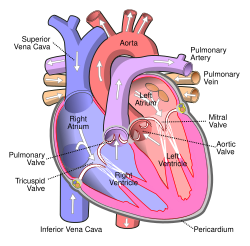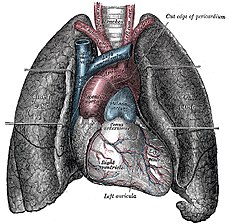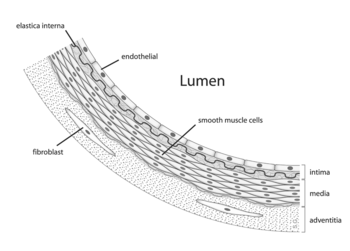User:BIO11VT8
Cardiovascular System[edit]

The Human Circulatory System

The human Circulatory System is a closed system consisting of arteries arterioles, capillaries, venules, and veins. Aterties and arterioles take blood, usually oxygenated, away from the heart. Veins and venules return blood, usually deoxygenated, to the heart. The capillaries are the place where, gas, water, ions, etc. are exchanged between the blood and the tissue.
There are 4 chambers to the human heart, left and right atria, and left and right ventricles. Blood flows into the right atrium from two major veins (Superior and Inferior Vena Cava). It then proceeds to the right ventricle and gets pumped to the longs through the pulmonary artery. The oxygenated blood comes back to the heart through the pulmonary veins into the left atrium. Next it goes into the Left ventricle and gets pumped into the body via the aorta.


A contraction of the heart starts from the sinoatrial node which fires an action potential to contract the atria. The action potential then reaches the atrioventricular node and is fired to contgract the ventricles. The ventricles and atria do not contract at the same time because of the lack gap junctions between cells of the atria and ventricles. The action potential from the atrioventricular node travels down the Bundle of His and up through the Purkinje Fibers to contract the ventricles. This composes one cardiac cycle.
The valves between the chambers keep the blood flowing in one direction. Atrioventricular valves are found between the atria and the ventricles. The aortic valve is found between the left ventricle and the aorta. The pulmonary valve is found between the pulmonary artery and the right ventricle.
The pulmonary system is between the lungs and the heart while the systemic system is between the heart and the rest of the body.
Arteries contain eleastic layers in their composition due to the high pressure of blood coming form the heart. Veins on the other hand contain valves to keep the blood flowing in one direction. The blood achieves this flow through contraction of skeletal muslces around them. Both veins and arteries contain smooth and endothelial tissue.
Capillaries consist only of a single layer of endothelial cells. Water, ions, and small molecules can easily pass through capillaries due to fenestrations which are tiny wholes in the capillaries.
Blood pressure is the driving force the forces ions and water to leave the blood at the arteriole level. To keep everything from being forced out, there is constant colloidal osmotic pressure that keeps some substance in the venules. Blood pressure is the force that varies, it is stronger at the artiole end than the venule end. These forces are called Starlings Forces (1).
Blood[edit]
Blood is fluid connective tissue. The extracellular matrix of this connective tissue is plasma. Reb blood cells or erythrocytes are the cells found in blood. They have a distinct shape, circular and concave on both sides. White blood cells or leukocytes are also found in the blood. Platelets, which help in blood clotting are a third substance found in the blood. The clot blood by flocking to an injury in the blod vessel where collagen fibers are exposed. This collection of platelets forms a "plug." Fibrin is the meshwork that seals the blood vessel(1).
1. Purves WK, Sadava D, Orians GH, Heller HC. Life The Science of Biology 7th Edition. United States of America: Courier Companies Inc; 2004. 1021 p.
Parental Influence on Cardiovascular responses in Children[edit]
Cardiovascular responses in children to stressors may be linked to their background (JT)
Children are commonly affected by the environment they live in. If that child’s parents are constantly fighting, the anger that child experiences can affect them. Repeated displays of anger may cause a child to react emotionally or behaviorally (1).
A study was conducted to see whether children with essential hypertensive (EH) parents responded differently than children with normotensive parents. Children with EH parents are at a higher risk to develop EH (2).
The results showed that sons of EH parents experienced heightened systolic and diabolic blood pressure, and also a raised heart rate, this was not seen in the daughter of EH parents. It was also thought that a child’s reaction to stressors might be dependent on their environment (2).
1. Cummings JS, Pellegrini D, Notarius C, Cummings EM. Children’s responses to angry adult behavior as a function of marital distress and history of interparent hostility. Child Development 1987: 60; 1035.
2. Paffenbarger PS, Thorne MC, Wing AL. Chronic disease in former college students. VIII. Characteristics of youth predisposing to hypertension in later years. American Journal of Epidemiology 1968: 88; 25-32.
